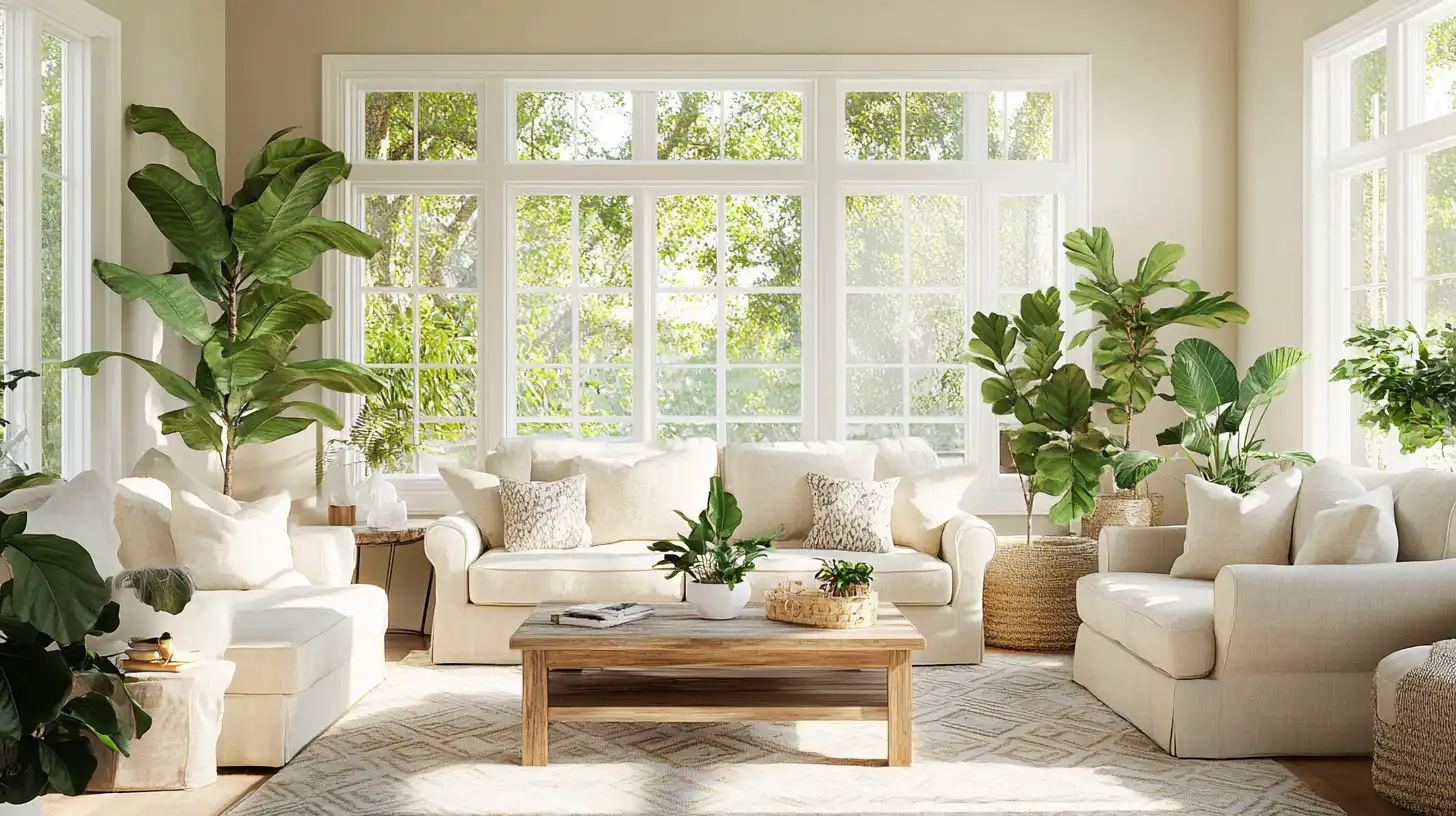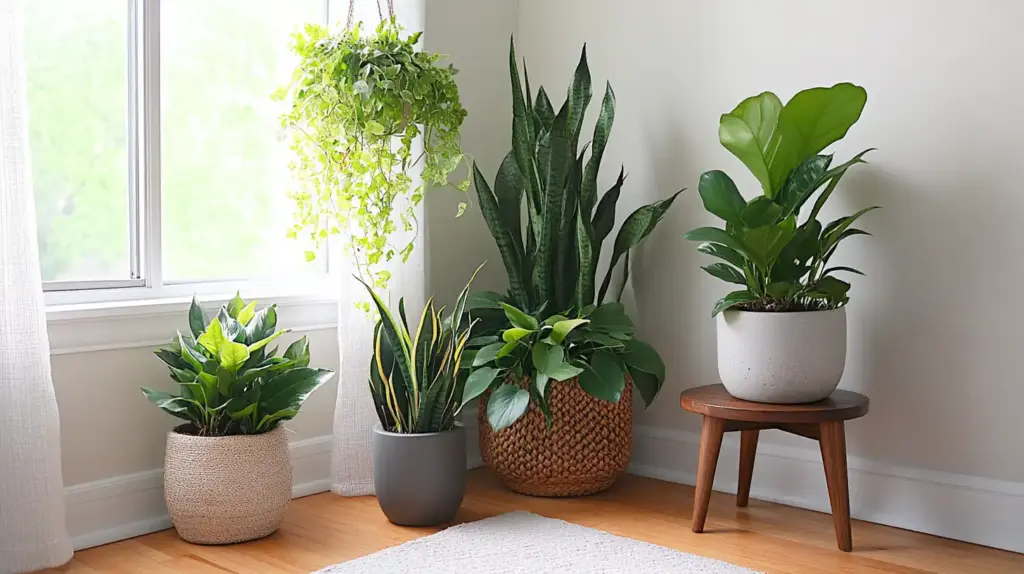Indoor Plant Styling is more than just placing a few pots on windowsills — it’s a thoughtful, creative way to design a space that feels alive and welcoming.
Whether you’re working with a cozy apartment or redesigning a spacious living room, indoor plant styling can dramatically shift the mood of your home. It introduces calm, warmth, and natural texture that instantly elevates your surroundings.
Start with the basics: select containers that complement your décor, experiment with plant heights, and layer them for visual depth. Incorporate organic elements like wood or stone to add warmth and structure.
If you love switching things up seasonally, consider pairing your indoor displays with shade-tolerant vegetables or low-maintenance outdoor potted plants. These add variety while expanding your greenery beyond the interior.
In this guide, we’ll explore 12 expert-approved indoor plant styling tips to help you create a home that blooms with life all year long.
🌿 Love gardening inspiration? Follow me on Pinterest for bold plant ideas, tips, and seasonal color!
Table of Contents
🪴 1. Create a Plant Corner
Designating a cozy plant corner is one of the simplest yet most impactful indoor plant styling strategies. Choose an underutilized space — a sunny nook, an awkward corner, or even next to a bookshelf — and transform it into a lush focal point.
Layering is key:
- Start with a tall anchor plant like a fiddle leaf fig or monstera.
- Add mid-sized plants on stools or plant stands.
- Place trailing varieties like pothos or ivy on elevated surfaces to cascade naturally.
To enhance dimension and draw the eye, mix in varying textures and leaf shapes. This setup not only brings vitality into your room but also mimics the layered structure of natural ecosystems. Bonus: groupings of plants help boost humidity, benefiting the plants themselves!
📚 2. Utilize Shelving for Elevated Indoor Plant Styling
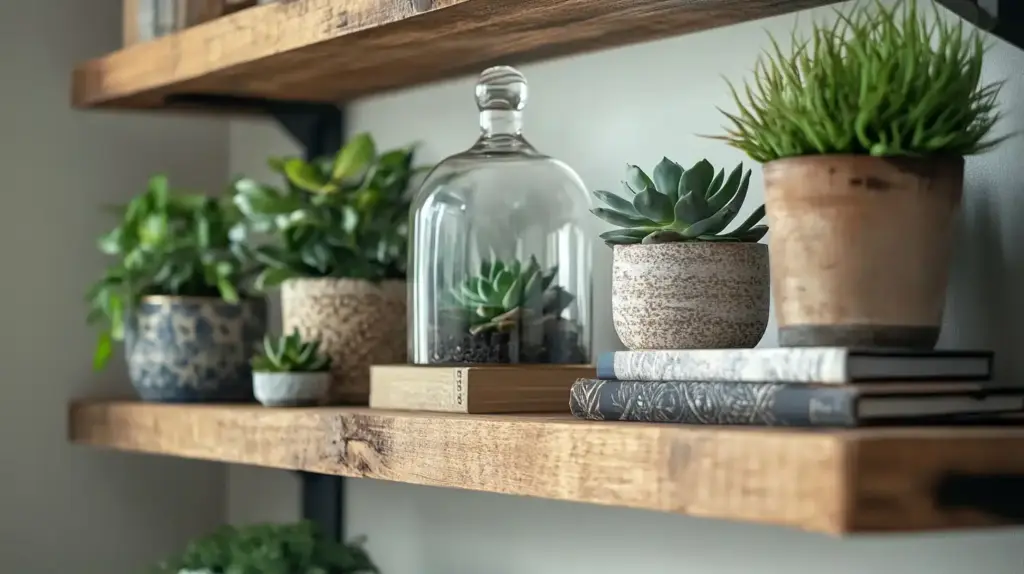
Shelves aren’t just for books and knick-knacks — they’re perfect platforms for displaying your indoor plants with style and function. Incorporating greenery into your shelving system not only saves space but also adds vibrant life to your vertical surfaces.
Here’s how to do it right:
- Use floating shelves in living rooms, kitchens, or home offices to create pockets of greenery at eye level.
- Combine small and medium-sized plants with personal decor items like framed photos, candles, or ceramics for a curated, eclectic vibe.
- Mix plant types and textures — think feathery ferns next to upright succulents.
- Add glass planters or terrariums for a modern, minimalist touch.
Styling shelves with plants is also a great way to play with light — many indoor plants thrive near windows, and a tiered shelf lets you rotate them for balanced sun exposure.
🪜 3. Create a Plant Ladder Display

Looking for a unique way to showcase your indoor plant styling skills? A plant ladder display is a charming and vertical solution that blends rustic character with practical design. Repurposing a simple wooden ladder lets you turn unused vertical space into a dynamic indoor garden.
Here’s how to style it:
- Choose a vintage ladder or paint/stain a basic wooden one to match your room’s color palette.
- Arrange plants by size, with larger pots on the lower steps and small trailing or bushy plants on top.
- Add string lights or fairy lights to create a cozy, inviting glow in the evenings.
- Use a mix of ceramic, clay, or textured pots for added visual interest.
This setup works beautifully in corners, against blank walls, or even beside large furniture like sofas or credenzas. It draws the eye upward, making the space feel taller and more open — a clever trick for small rooms.
🌿 4. Incorporate Plant Hangers for Vertical Charm
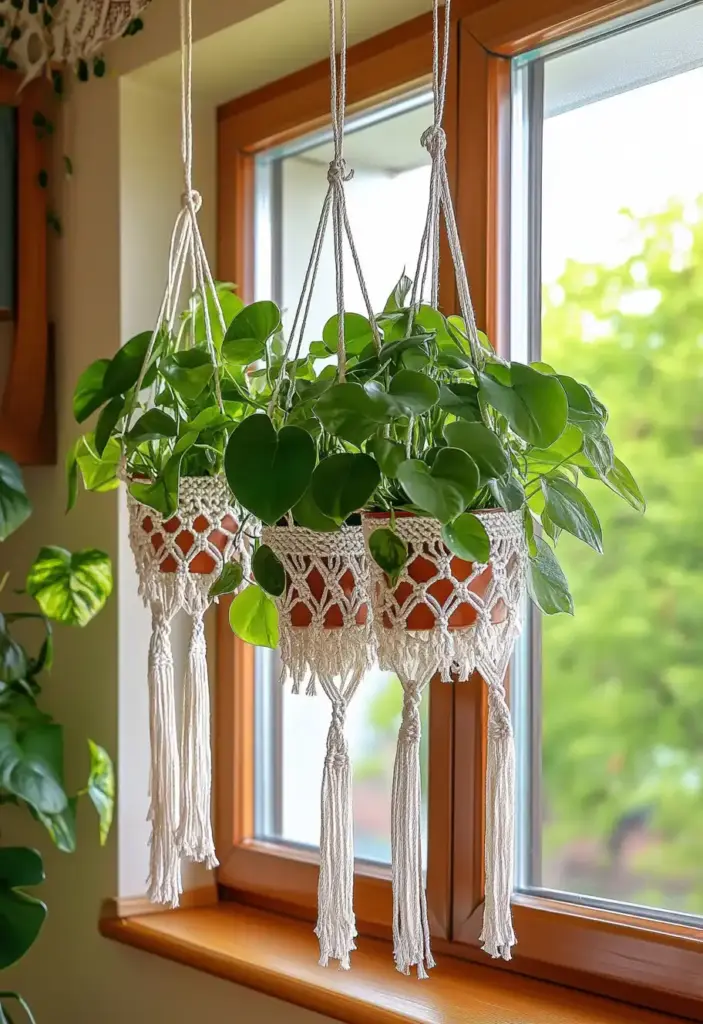
Plant hangers are a go-to solution when you’re tight on floor space but still want to embrace indoor plant styling. By suspending plants from the ceiling or wall brackets, you not only save room but also introduce a new layer of visual interest that draws the eye upward.
To get the look:
- Use macramé hangers for a boho feel, or opt for sleek metal or ceramic hangers for a modern aesthetic.
- Hang cascading plants like string of pearls, spider plants, or philodendrons to add movement and volume.
- Vary the height and spacing of each hanger to create a more organic, gallery-like arrangement.
- Consider placing hangers near windows or in corners to utilize natural light and soften angular architecture.
Plant hangers are especially useful in tight apartments, studio lofts, or any home where floor real estate is limited but the ceiling has room to shine.
📏 5. Mix Plant Sizes for Visual Balance
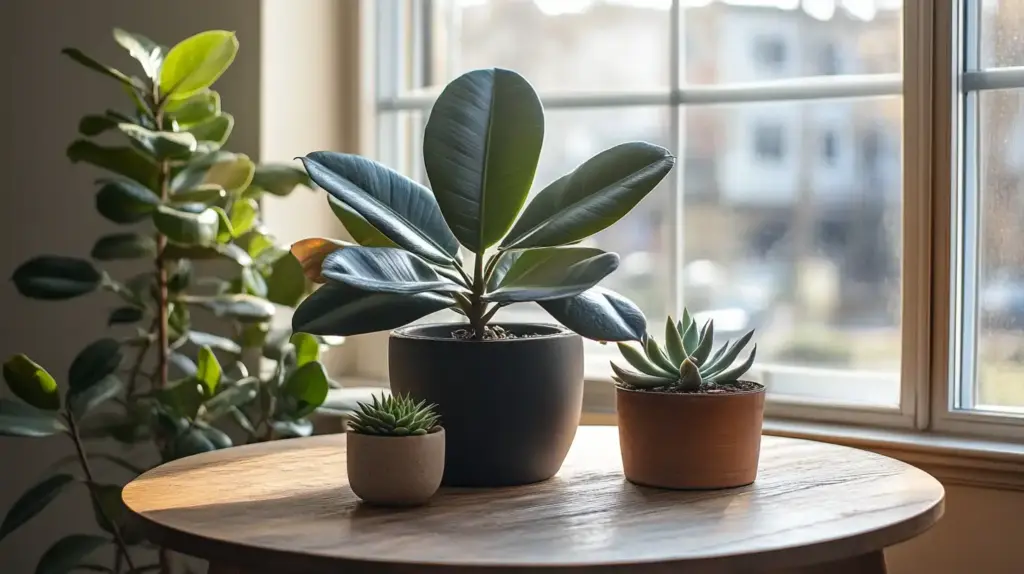
An essential principle of effective indoor plant styling is variety — and that includes mixing plant sizes. When you thoughtfully combine tall, medium, and small plants, you create visual rhythm and balance that mimics nature and keeps your space feeling dynamic.
Here’s how to style with size in mind:
- Anchor your arrangement with a tall statement plant like a rubber tree, palm, or fiddle leaf fig.
- Add medium-height plants like peace lilies, calatheas, or ZZ plants around the base or nearby surfaces.
- Fill in with compact species like succulents, cacti, or herbs on window ledges, coffee tables, or floating shelves.
- Use stands or risers to elevate shorter plants and achieve a more tiered, layered composition.
The key is contrast — height, width, and leaf shape should all work together to lead the eye across the room without feeling cluttered.
🌟 6. Use Unique Containers to Express Your Style
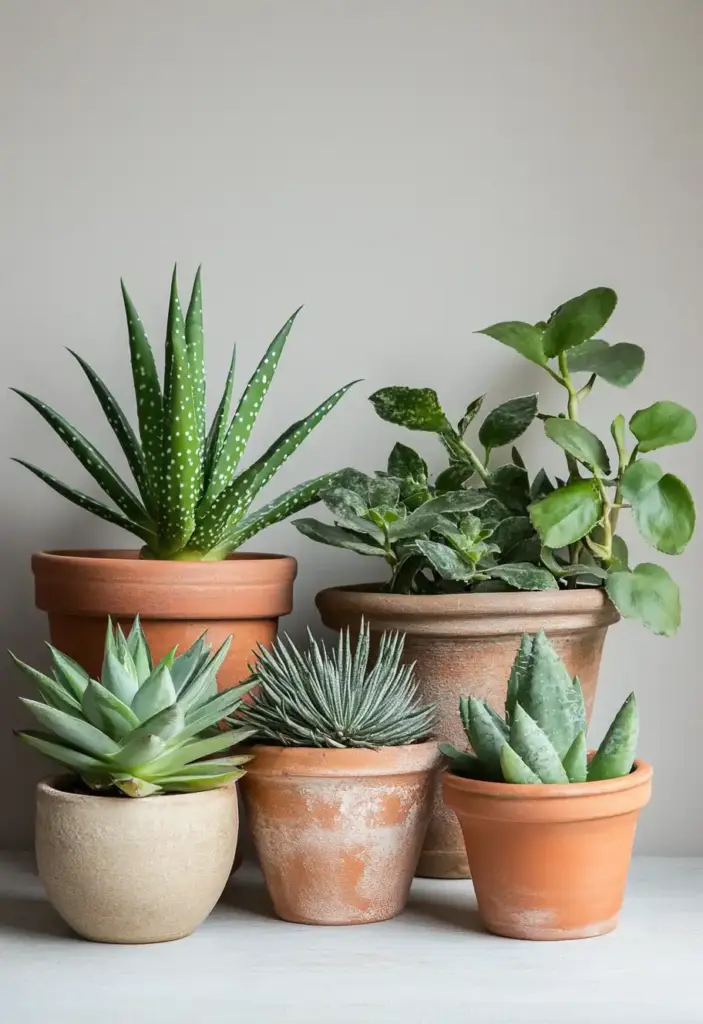
In indoor plant styling, the pot is just as important as the plant. Choosing the right container can elevate your entire design, turning even the most common houseplants into standout décor pieces.
Tips for choosing stylish containers:
- Go beyond basic terracotta — try ceramic, concrete, woven baskets, or even repurposed items like vintage tins or teapots.
- Mix textures and finishes to add depth — matte, glazed, rough, or metallic pots each create a different mood.
- Stick to a cohesive color scheme (e.g., neutrals or earth tones) for a harmonious look, or go bold with eclectic, mismatched pots for a boho vibe.
- Use elevated stands or trays to tie clusters of containers together visually and protect your floors or shelves.
Remember, the right container does more than hold a plant — it frames it, highlights it, and integrates it seamlessly into your room’s aesthetic.
🌱 7. Go Vertical with a Green Wall
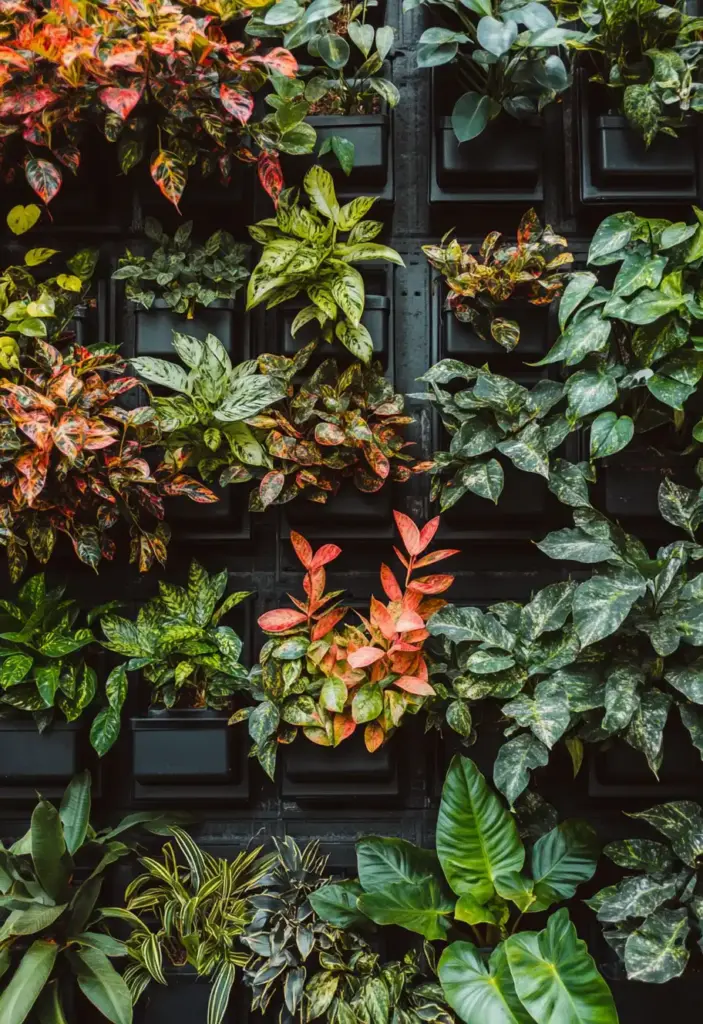
If you’re looking to make a bold botanical statement, a green wall is a game-changer in indoor plant styling. This living feature turns any plain wall into a lush, textured backdrop that breathes life into your space — literally and visually.
How to create your own green wall:
- Use modular wall planters, hanging trellises, or a vertical shelving unit to hold your greenery.
- Choose low-maintenance, lush plants like pothos, ferns, philodendrons, or even trailing herbs for kitchen setups.
- Arrange plants densely but thoughtfully, alternating leaf shapes and shades of green for natural contrast.
- Place your green wall in a well-lit area, ideally with indirect sunlight to support healthy growth.
- For a polished look, add backlighting or incorporate it into a feature wall with wood or stone accents.
Besides being a showstopper, green walls can improve indoor air quality and add a soothing sense of nature to urban living.
🪴 8. Layer Your Plants for Depth and Dimension
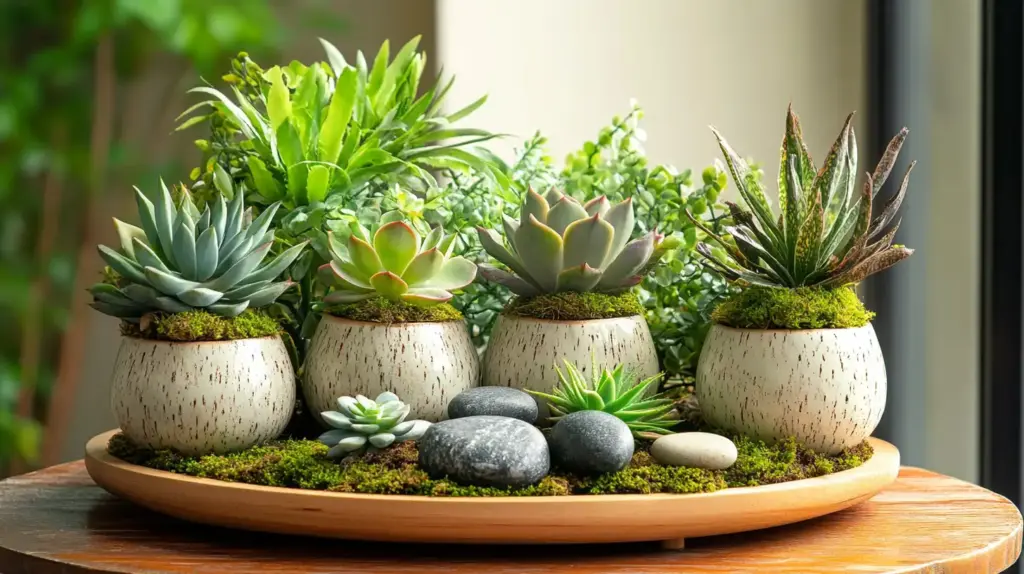
One of the hallmarks of expert indoor plant styling is the ability to mimic how plants grow in nature — and that starts with layering. By arranging plants at different heights and depths, you create a visually rich, immersive space that feels both intentional and organic.
How to layer plants effectively:
- Position taller plants like dracaenas or fiddle leaf figs at the back or corners of your layout.
- Add mid-height plants on stands or furniture to fill in the midline of your visual field.
- Place smaller or trailing plants in the foreground or on lower shelves to round out the arrangement.
- Use plant stands, stools, stackable crates, or even books to stagger height levels without overcrowding.
- Incorporate textures like moss, decorative rocks, or woven baskets at the base for added interest.
This approach not only enhances aesthetics but also ensures that each plant gets the light and airflow it needs, keeping your indoor jungle both beautiful and healthy.
🍽 9. Use Plants as Centerpieces for Natural Elegance
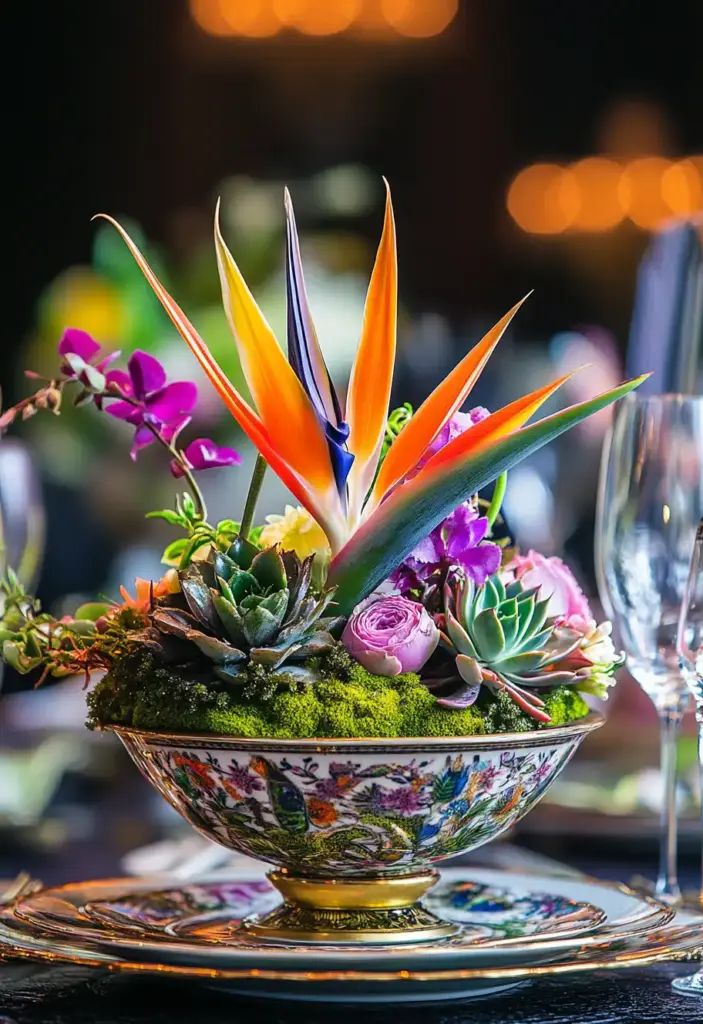
Elevate your home’s décor by making plants the heart of your tablescape. Using greenery as a centerpiece adds a refreshing, organic element to dining areas, coffee tables, or sideboards — blending functionality with natural beauty in your indoor plant styling efforts.
Centerpiece styling tips:
- Choose low-profile plants that don’t block conversation — think bonsai, echeveria, or small calatheas.
- Use a single statement plant in a decorative pot for minimalist appeal, or cluster a few small pots in a shallow tray for a fuller look.
- Consider seasonal arrangements — like succulent bowls in summer or amaryllis in winter — to keep things feeling fresh and festive.
- Add accents like candles, pebbles, or driftwood to enhance the design without overwhelming it.
- For dining tables, prioritize plants with little to no scent to avoid clashing with food aromas.
This approach turns everyday surfaces into eye-catching green moments that tie the whole room together.
🌲 10. Incorporate Natural Elements to Deepen the Organic Feel
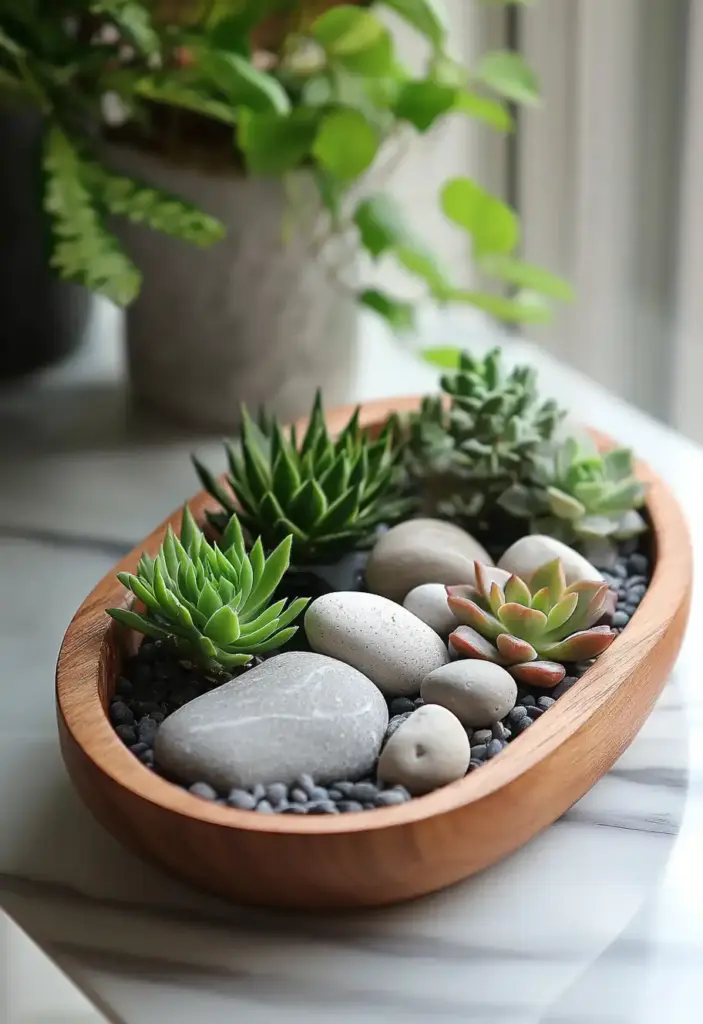
True indoor plant styling goes beyond greenery — it’s about creating a cohesive environment that celebrates nature. Integrating other natural materials like wood, stone, and even water helps ground your plant displays and enhances the calming, biophilic vibe.
Ideas to enhance your plant decor with natural elements:
- Use wooden trays, reclaimed shelves, or bamboo stands to display plant groupings.
- Pair plants with natural stone planters, river rocks, or ceramic pots in earthy tones.
- Incorporate driftwood, cork bark, or woven baskets to add organic textures.
- Introduce a tabletop water feature or small indoor fountain for sound and movement.
- Surround larger plants with a mossy base or natural mulch to evoke a forest-floor aesthetic.
These earthy additions not only enhance the visual harmony but also strengthen the connection between your indoor environment and the natural world outside.
🌺 11. Highlight Focal Plants to Anchor Your Space
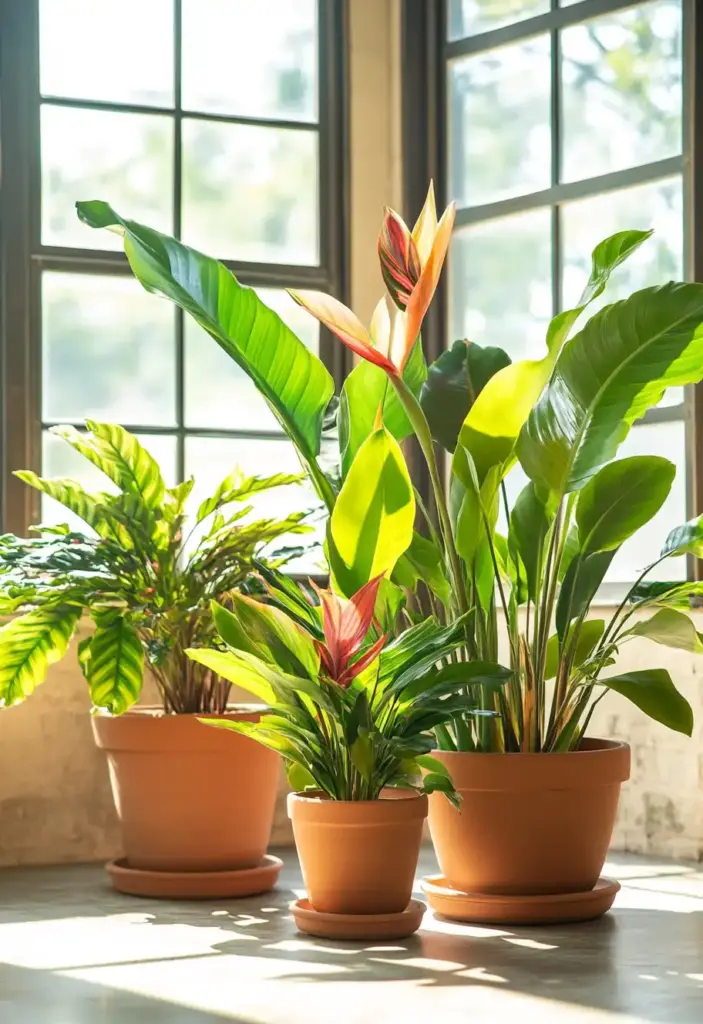
Every thoughtfully styled room benefits from a showstopper — and in indoor plant styling, that role belongs to your focal plant. These standout specimens serve as living sculptures, anchoring your design and drawing attention to your home’s most beautiful features.
How to make a plant a focal point:
- Choose bold, large-scale plants like bird of paradise, monstera deliciosa, or a lush fiddle leaf fig.
- Position them in high-traffic or highly visible areas such as entryways, beside the sofa, or next to large windows.
- Use a statement planter — perhaps something textured, oversized, or in a contrasting color — to amplify the drama.
- Keep the surrounding area simple so the eye doesn’t compete with clutter.
- Spotlight the plant with natural light or even accent lighting to enhance its shape and color.
Focal plants not only define space but also reflect your personality — bold, graceful, or playful — depending on what species you choose to showcase.
🍁 12. Seasonal Plant Swaps to Keep Your Decor Fresh
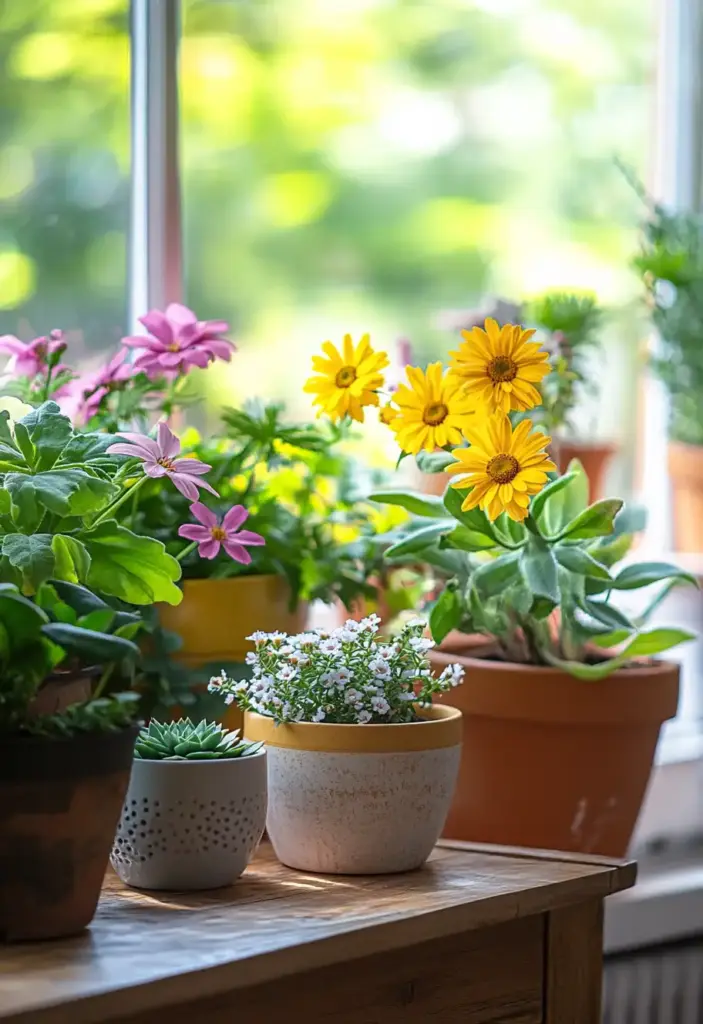
One of the most underrated secrets of exceptional indoor plant styling is the power of seasonal rotation. Just like you update your wardrobe or decor with the seasons, your indoor garden can reflect the time of year — keeping your home feeling fresh, current, and full of life.
Here’s how to rotate plants seasonally:
- In spring, bring in flowering plants like orchids or African violets to celebrate renewal.
- For summer, try tropical plants like bromeliads or palms that thrive in brighter, warmer conditions.
- During fall, accent with golden-hued foliage like crotons or include decorative gourds and small mums.
- In winter, add festive cheer with poinsettias, Norfolk pines, or deep green ferns for cozy vibes.
Keep off-season plants in a shaded room or protected patio if your climate allows. Swapping plants not only keeps your space visually interesting but also introduces new scents, textures, and colors throughout the year — without requiring a total redesign.
🧾 Conclusion: Curate Your Own Indoor Plant Paradise
Indoor Plant Styling is far more than a decorative trend — it’s a mindful approach to infusing your space with balance, vitality, and a touch of nature’s charm. By layering your greenery, selecting unique containers, and embracing seasonal swaps, indoor plant styling becomes a creative outlet and a form of self-expression. Whether you’re highlighting a bold focal plant or creating a calming corner, every decision adds personality to your space.
If you’re just beginning your indoor gardening journey, you might find inspiration from our guide on how to grow and care for pothos plants — a perfect companion to your styling efforts. Already a seasoned plant parent? Explore creative flower pot ideas to give your setup an extra aesthetic boost.
So grab your favorite plant stand, reimagine your layout, and let these indoor plant styling tips guide you in building a truly lush and personalized sanctuary — one leaf at a time.
❓ Frequently Asked Questions (FAQ)
🌿 What is indoor plant styling?
Indoor plant styling refers to the thoughtful arrangement and display of houseplants to enhance your home’s decor, mood, and overall ambiance. It involves selecting the right plants, containers, and placements to complement your interior style.
🪴 How do I choose the right plants for indoor styling?
Consider your lighting conditions, maintenance preferences, and design goals. Low-light rooms benefit from plants like snake plants and pothos, while sunny spots are great for succulents and fiddle leaf figs. Always choose plants that match your lifestyle and space.
🧼 How do I keep indoor plants looking clean and styled?
Wipe leaves regularly with a damp cloth to remove dust. Rotate plants weekly for even growth and maintain tidy containers. Remove dead leaves or debris to keep displays fresh and polished.
🏡 Can indoor plant styling improve my home’s atmosphere?
Absolutely! Plants purify air, reduce stress, and introduce natural elements that soften hard architectural lines. A well-styled plant corner can create a cozy, calming vibe that improves both visual and emotional comfort.
🧺 How often should I change or update my plant styling?
While your core layout can stay the same, consider seasonal updates every few months. Swap containers, introduce new plants, or re-style shelves to keep things feeling fresh and aligned with the time of year.

